

New mayor seeks cooperation, also higher developer fees
Developers with projects in the pipeline can expect to be asked to provide more affordable housing and a stronger community benefits package before being approved, Mayor-elect Jesse Arreguín said Monday during a far-ranging interview with Berkeleyside.
Now that the self-described progressives have the City Council majority (see below for more details) the “previous approach” to development will change, he said.
“I do think the voters wanted a change,”Arreguín said at PIQ on Shattuck Avenue. “That’s one of the reasons I was elected by such a large margin. One of the issues I heard throughout the city of Berkeley was a concern about the major demographic changes, the changes to the character of the place, long-time businesses being displaced, the scale of development.”
“I think the voters of Berkeley want more equitable, responsible growth,” he said. “That is not to say everything is going to come to a grinding halt. We need to create more housing so, certainly, under my administration, we are going to encourage the construction of transit-oriented development in Berkeley.”…
Link to article
Mexican American Proarchive: Annual Report on Mexican American Professionals
News from the census American Community Survey is generally good for the 2015 year. Mexican American college enrollment was up from 18.7% to 18.9% in the 2014 and 2015 years. Graduate or professional degree attainment was also up from 2.9% to 3.0%. The number of bachelor’s degrees granted to Mexican American students rose from 7.6% in 2014 to 7.8% in 2015.


In spite of these gains, Mexican Americans still remain at the bottom of the ladder when it comes to earning a bachelor’s degree. Even after broadening the group to Latinos or Hispanics, this group still lags behind. According to the Pew Hispanic Center: “As of 2014, among Hispanics ages 25 to 29, just 15% of Hispanics have a bachelor’s degree or higher. By comparison, among the same age group, about 41% of whites have a bachelor’s degree or higher (as do 22% of blacks and 63% of Asians).” Pew reports that the main reasons for this low graduation rate is that Hispanics are less likely “to enroll in a four-year college, attend an academically selective college and enroll full-time.”
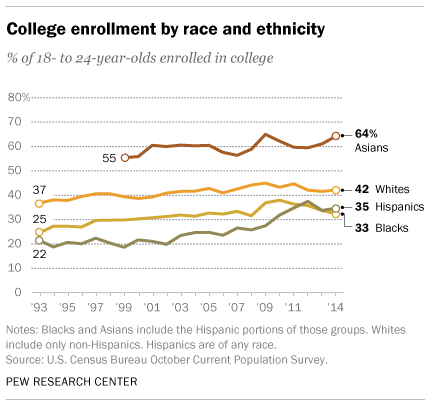
Also in the good news column, the University of California will continue to push for a greater number of underrepresented minorities; namely, Chicano/Latino students whose resident freshmen numbers rose from 2.7% to 32.3% of admitted California freshmen. In other good news, the proportion of Chicano/Latino students transferring from community colleges increased to 29.3% from 26.8% for 2015.
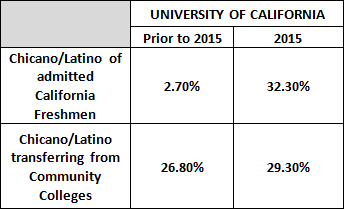
Occupations, including those in management, business, science, and art, fared better for Mexican Americans. The number of Mexican Americans filling these occupations rose from 17.4% in 2014 to 17.5% in 2015.

The total number of Hispanics filling these occupations was 16.1% in 2015, a bit lower than Mexican Americans specifically.
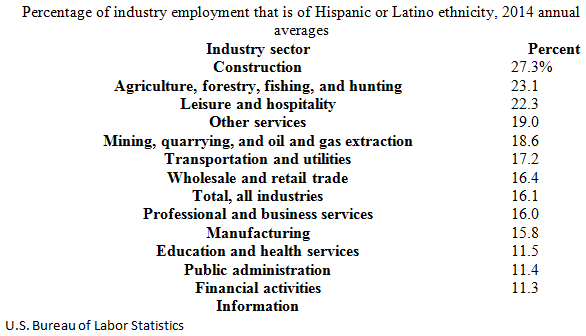
The report shows that industrial employment for Mexican Americans remained the same for 2014 and 2015 at 10.2%.
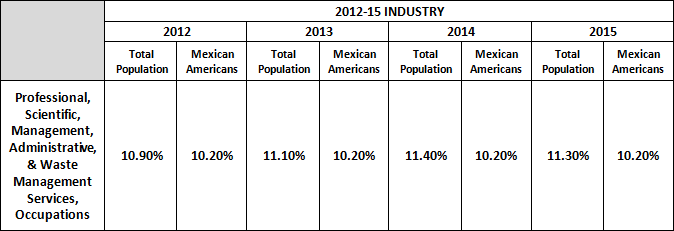
The figures for Hispanic or Latino employment for 2015 and 2016 show a healthy increase.
According to the Pew Hispanic center, “Construction, professional and business services, health services, financial services and food services…showed healthy gains.” Most of the jobs gained by native-born Hispanic workers were in manufacturing, mostly durable goods (82,000 Hispanic workers in this industry), followed by wholesale and retail trade (79,000), publishing, broadcasting, communication and information services (55,000), and construction (54,000).
Foreign-born Hispanics had the most job gains in construction (417,000), followed by business and professional services (179,000). Together, those two industries accounted for almost three-quarters (74%) of all jobs gained by foreign-born Latinos between 2005 and 2006.
The business and professional services sector, which ranges from management and technical services to janitorial, landscaping, and waste management services, is also a key employer for non-Hispanic workers. Of the total increase in employment in 2005-06, non-Hispanic workers accounted for 410,000 employees in the industry, native-born workers 327,000, and foreign-born workers 83,000.
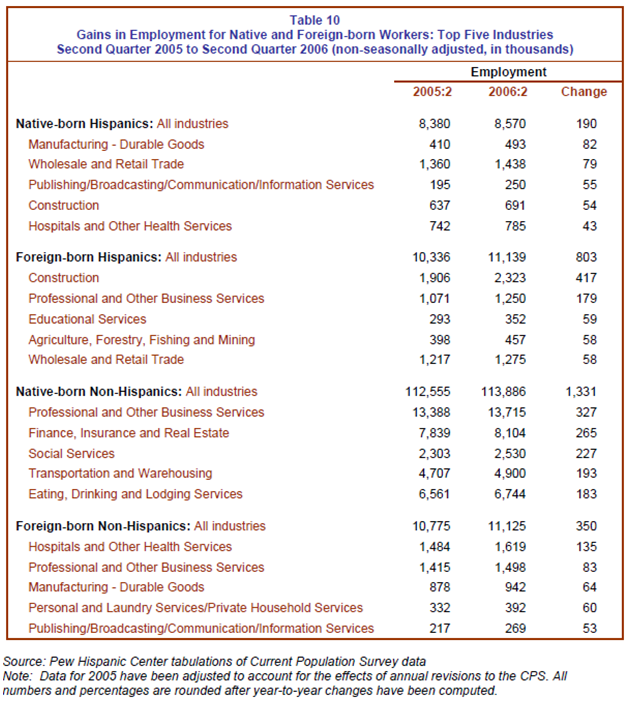
Sources
- Census Bureau, Selected Population Profile in the United States: 2015
- Pew Research Center
- University of California
- Bureau of Labor Statistics
Event speaker says Texas’ Hispanic community is an economic powerhouse that will only continue to grow
The Hispanic community is a growing part of the economic engine of Texas, marketing pro Terry Soto said at the annual Hispanic Business Achievers luncheon on Wednesday.
“To market to our community, thinking about a market that used to exist 10 or 20 years ago doesn’t work,” Ms. Soto explained. “We have to evolve our thinking and our approach to this community.”
Ms. Soto, president and CEO of About Marketing, has worked with Fortune 500 organizations including Walgreen’s, ALDI Supermarkets, Verizon Wireless Coca Cola, Citibank, Kraft Foods and Disney, among others. She told a capacity crowd at Harvey Convention Center that the Hispanic community will continue to grow as an economic and demographic force in Tyler and the rest of the nation…
Link to article
As population booms, so do Hispanic businesses
It only seemed natural that the Díaz family would go into business for themselves some day.
Father Ruben worked in horticultural for years. Sons Rafael and Ruben Jr. went to school to specialize in business and horticulture management.
In 2007, the three teamed up to create the Díaz Group LLC, a Chicago-area landscape and brick paving contractor.
The company has grown since then. Rafael now serves on the board of the National Hispanic Landscape Alliance. Other Diaz family members have joined the Diaz Group. Their services have been featured on HGTV.
The Díazes are typical of many Hispanic-owned businesses. They are often family-owned, launched within the past 14 years, and concentrated in service industries such as landscaping and retail…
Link to article
Immigration Reform 2016 News – Facebook and Microsoft Say STEM, Immigrants Help U.S. Tech Companies Stay Competitive
Representatives from the country’s most affluent companies challenged the next presidential administration to revise education and immigration programs during a Democratic National Convention forum on Wednesday.
Members of the nonpartisan Information Technology and Innovation Foundation, which pushes for scientific and technological advancements, urged lawmakers to reform longstanding immigration laws that limit how long individuals can work or study in the United States. The panelists also said a lack of enthusiasm for STEM – science, technology, engineering, and mathematics – education programs among minorities makes it difficult to compete globally…
Link to article
A Latino Angel Wants To Help You Invest In Tech Startups
For the past two decades, I have been an advisor to many technology startups, and I can tell you this: raising the first million is the hardest.
Even harder: raising the first million if you are Latino/Latina founder.
Last week, DreamFunded – a San Francisco-based company that I’ve written about before — became the first SF-headquartered firm to get approval from FINRA to launch a portal that will enable many people — not just the rich — to invest in technology through crowdfunding. According to DreamFunded, it’s also the first Latino-led equity crowdfunding portal anywhere to get FINRA approval…
Link to article
Michael Zajur, President of the Virginia Hispanic Chamber of Commerce
HOW HE HAS SHAPED THE REGION: Zajur, as head of the chamber, has provided a voice for the Hispanic business community during a period in which the Hispanic population in Virginia essentially doubled.
In 2000, the year Zajur founded the chamber, about 4.7 percent of the state’s population was Hispanic or Latino. In 2014, that percentage was up to 9 percent…
Link to article


